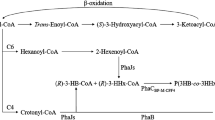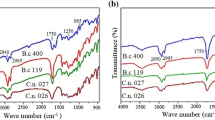Abstract
Waste rapeseed oil is a useful substrate for polyhydroxyalkanoates (PHA) production employing Cupriavidus necator H16. In fed-batch mode, we obtained biomass and PHA yields of 138 and 105 g l−1, respectively. Yield coefficient and volumetric productivity were 0.83 g PHA per g oil and 1.46 g l−1 h−1, respectively. Propanol at 1% (v/v) enhanced both PHA and biomass formation significantly and, furthermore, resulted in incorporation of 3-hydroxyvalerate units into PHA structure. Thus, propanol can be used as an effective precursor of 3-hydroxyvalarete for production of poly(3-hydroxybutyrate-co-3-hydroxyvalerate) copolymer. During the fed-batch cultivation, propanol concentration was maintained at 1% which resulted in 8% content of 3-hydroxyvalerate in copolymer.


Similar content being viewed by others
References
Brandl H, Gross RA, Lenz RW, Fuller RC (1988) Pseudomonas oleovorans as a source of poly(beta-hydroxyalkanoates) for potential application as a biodegradable polyester. Appl Environ Microb 54:1977–1982
Chan PL, Yu V, Wai L, Yu HF (2006) Production of medium-chain-length polyhydroxyalkanoates by Pseudomonas aeruginosa with fatty acids as alternative carbon sources. Appl Biochem Biotechnol 129:933–941
Du GC, Chen J, Yu J, Lun S (2001) Feeding strategy of propionic acid for production of poly(3-hydroxybutyrate-co-3-hydroxyvalerate) with Ralstonia eutropha. Biochem Eng J 8:103–110
Kahar P, Tsuge T, Taguchi K, Doi Y (2004) High yield production of polyhydroxyalkanoates from soybean oil by Ralstonia eutropha and its recombinant strain. Pol Degrad Stabil 83:79–86
Kessler B, Witholt B (1999) Poly(3-hydroxyalkanoates) In: Flickinger MC, Drew SW (eds) Encyclopedia of bioprocess technology—fermentation, biocatalysis and bioseparation. Wiley, New York, pp 2024–2040
Lee SY, Choi J (1999) Effect of fermentation performance on the economics of poly-(3-hydroxybutyrate) production by Alcaligenes latus. Pol Degrad Stabil 59:387–393
Matthäus B (2007) Use of palm oil for frying in comparison with other high-stability oils. Eur J Lipid Sci Technol 109:400–409
Obruca S, Marova I, Svoboda Z, Mikulikova R (2010a) Use of controlled exogenous stress for improvement of poly(3-hydroxybutyrate) production in Cupriavidus necator. Folia Microbiol 55:17–22
Obruca S, Marova I, Stankova M, Mravcova L, Svoboda Z (2010b) Effect of ethanol and hydrogen peroxide on poly(3-hydroxybutyrate) biosynthetic pathway in Cupriavidus necator H16. World J Microb Biot 26:1261–1267
Slater S, Houmiel KL, Tran M, Mitsky TA, Taylor NB, Padgette SR, Gruys KJ (1998) Multiple beta-ketothiolases mediate poly(beta-hydroxyalkanoate) copolymer synthesis in Ralstonia eutropha. J Bacteriol 180:1979–1987
Taniguchi I, Kagotani K, Kimura Y (2003) Microbial production of poly(hydroxyalkanoates) from waste edible oils. Green Chem 5:545–548
Vidal-Mas J, Resina-Pelfort O, Haba E, Comas J, Manresa A, Vives-Rego J (2001) Rapid flow cytometry—Nile red assesment of PHA cellular content and heterogeneity in cultures of Pseudomonas aeruginosa 47T2 (NCIB 40044) grown in waste frying oil. Anton Leeuw Int J G 80:57–63
Acknowledgments
This work was supported by projects MSM 0021630501 and CZ.1.05/2.1.00/01.0012 of the Czech Ministry of Education.
Author information
Authors and Affiliations
Corresponding author
Rights and permissions
About this article
Cite this article
Obruca, S., Marova, I., Snajdar, O. et al. Production of poly(3-hydroxybutyrate-co-3-hydroxyvalerate) by Cupriavidus necator from waste rapeseed oil using propanol as a precursor of 3-hydroxyvalerate. Biotechnol Lett 32, 1925–1932 (2010). https://doi.org/10.1007/s10529-010-0376-8
Received:
Accepted:
Published:
Issue Date:
DOI: https://doi.org/10.1007/s10529-010-0376-8




